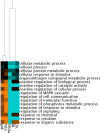Exploration of binary protein-protein interactions between tick-borne flaviviruses and Ixodes ricinus
- PMID: 33676573
- PMCID: PMC7937244
- DOI: 10.1186/s13071-021-04651-3
Exploration of binary protein-protein interactions between tick-borne flaviviruses and Ixodes ricinus
Abstract
Background: Louping ill virus (LIV) and tick-borne encephalitis virus (TBEV) are tick-borne flaviviruses that are both transmitted by the major European tick, Ixodes ricinus. Despite the importance of I. ricinus as an arthropod vector, its capacity to acquire and subsequently transmit viruses, known as vector competence, is poorly understood. At the molecular scale, vector competence is governed in part by binary interactions established between viral and cellular proteins within infected tick cells.
Methods: To investigate virus-vector protein-protein interactions (PPIs), the entire set of open reading frames for LIV and TBEV was screened against an I. ricinus cDNA library established from three embryonic tick cell lines using yeast two-hybrid methodology (Y2H). PPIs revealed for each viral bait were retested in yeast by applying a gap repair (GR) strategy, and notably against the cognate protein of both viruses, to determine whether the PPIs were specific for a single virus or common to both. The interacting tick proteins were identified by automatic BLASTX, and in silico analyses were performed to expose the biological processes targeted by LIV and TBEV.
Results: For each virus, we identified 24 different PPIs involving six viral proteins and 22 unique tick proteins, with all PPIs being common to both viruses. According to our data, several viral proteins (pM, M, NS2A, NS4A, 2K and NS5) target multiple tick protein modules implicated in critical biological pathways. Of note, the NS5 and pM viral proteins establish PPI with several tumor necrosis factor (TNF) receptor-associated factor (TRAF) proteins, which are essential adaptor proteins at the nexus of multiple signal transduction pathways.
Conclusion: We provide the first description of the TBEV/LIV-I. ricinus PPI network, and indeed of any PPI network involving a tick-borne virus and its tick vector. While further investigation will be needed to elucidate the role of each tick protein in the replication cycle of tick-borne flaviviruses, our study provides a foundation for understanding the vector competence of I. ricinus at the molecular level. Indeed, certain PPIs may represent molecular determinants of vector competence of I. ricinus for TBEV and LIV, and potentially for other tick-borne flaviviruses.
Conflict of interest statement
The authors declare that they have no competing interests.
Figures





Similar articles
-
Tick-borne pathogens induce differential expression of genes promoting cell survival and host resistance in Ixodes ricinus cells.Parasit Vectors. 2017 Feb 15;10(1):81. doi: 10.1186/s13071-017-2011-1. Parasit Vectors. 2017. PMID: 28202075 Free PMC article.
-
Molecular Basis of a Protective/Neutralizing Monoclonal Antibody Targeting Envelope Proteins of both Tick-Borne Encephalitis Virus and Louping Ill Virus.J Virol. 2019 Apr 3;93(8):e02132-18. doi: 10.1128/JVI.02132-18. Print 2019 Apr 15. J Virol. 2019. PMID: 30760569 Free PMC article.
-
Differential susceptibility of geographically distinct Ixodes ricinus populations to tick-borne encephalitis virus and louping ill virus.Emerg Microbes Infect. 2024 Dec;13(1):2321992. doi: 10.1080/22221751.2024.2321992. Epub 2024 Mar 14. Emerg Microbes Infect. 2024. PMID: 38484290 Free PMC article.
-
Louping ill virus: an endemic tick-borne disease of Great Britain.J Gen Virol. 2014 May;95(Pt 5):1005-1014. doi: 10.1099/vir.0.062356-0. Epub 2014 Feb 19. J Gen Virol. 2014. PMID: 24552787 Free PMC article. Review.
-
Steps of the tick-borne encephalitis virus replication cycle that affect neuropathogenesis.Virus Res. 2005 Aug;111(2):161-74. doi: 10.1016/j.virusres.2005.04.007. Virus Res. 2005. PMID: 15871909 Review.
Cited by
-
Systems Biology of Virus-Host Protein Interactions: From Hypothesis Generation to Mechanisms of Replication and Pathogenesis.Annu Rev Virol. 2022 Sep 29;9(1):397-415. doi: 10.1146/annurev-virology-100520-011851. Epub 2022 May 16. Annu Rev Virol. 2022. PMID: 35576593 Free PMC article. Review.
-
Potential Mechanisms of Transmission of Tick-Borne Viruses at the Virus-Tick Interface.Front Microbiol. 2022 May 5;13:846884. doi: 10.3389/fmicb.2022.846884. eCollection 2022. Front Microbiol. 2022. PMID: 35602013 Free PMC article. Review.
-
Development and Validation of an ELISA for the Detection of Bluetongue Virus Serotype 4-Specific Antibodies.Viruses. 2021 Aug 31;13(9):1741. doi: 10.3390/v13091741. Viruses. 2021. PMID: 34578322 Free PMC article.
-
Tick Importin-α Is Implicated in the Interactome and Regulome of the Cofactor Subolesin.Pathogens. 2021 Apr 11;10(4):457. doi: 10.3390/pathogens10040457. Pathogens. 2021. PMID: 33920361 Free PMC article.
-
Let's Get Physical: Flavivirus-Host Protein-Protein Interactions in Replication and Pathogenesis.Front Microbiol. 2022 Mar 3;13:847588. doi: 10.3389/fmicb.2022.847588. eCollection 2022. Front Microbiol. 2022. PMID: 35308381 Free PMC article. Review.
References
-
- Calisher CH. Antigenic classification and taxonomy of flaviviruses (family Flaviviridae) emphasizing a universal system for the taxonomy of viruses causing tick-borne encephalitis. Acta Virol. 1988;32:469–478. - PubMed
MeSH terms
Substances
Grants and funding
LinkOut - more resources
Full Text Sources
Other Literature Sources
Research Materials
Miscellaneous

